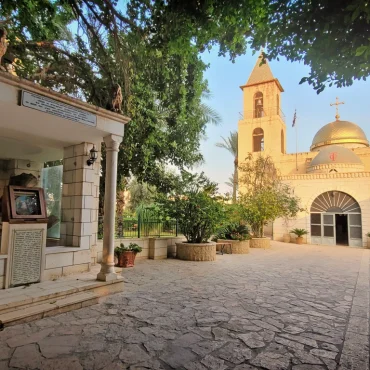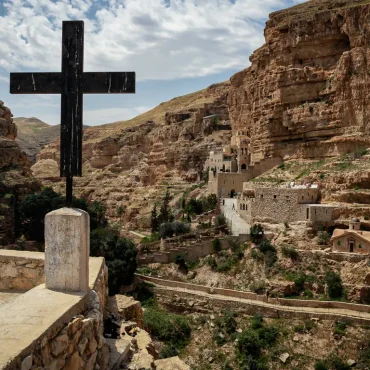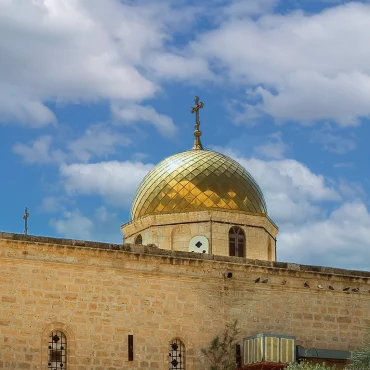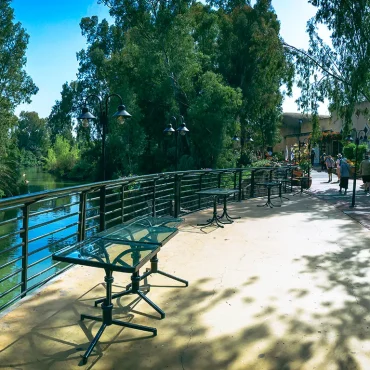The Holy Monastery of Temptation
Jericho
Jericho is the most ancient city of the Holy Land. It is a city of Jordan on the west side of the valley of river Jordan. One of the most ancient unceasingly populated cities in the world, Jericho has been the most fortified city of the Canaanites. It has a significant strategic position from which one can easily gain access to the interior of the Holy Land.
Its strategic position served as an attraction pole for all people. Christ often went through Jericho each time he travelled to Jerusalem from his home town Galilee. This is witnessed by the incidents with Zacchaeus the publican, His meeting with the born-blind man and His last entrance in Jerusalem.
In the 4th century Jericho was proclaimed Archdiocese, while in the 5th and 6th centuries it had become a significant Shrine and monastic centre. Many churches were built in Jericho during the Byzantine era. Notably, Elisha’s spring, Prophet Elijah’s cave and Zacchaeus’ sycamore tree were congested shrines.
أريحا
تُعتبر أريحا أقدم مدينة في فلسطين ومن أقدم المدن في التاريخ حيث يعود تاريخها إلى 10,000 سنة قبل الميلاد, وتقع على الضفة الغربية بالقرب من نهر الأردن وعند شمال البحر الميت وتُعتبر أخفض منطقة بالعالم وتُعرف أيضاً بإسم مدينة القمر, ولها موقع أستراتيجي هام.
يذكر ألانجيل أن السيد المسيح جاء الى أريحا عدة مرات عند قدومه من الجليل الى أورشليم, ويذكر أيضاً بعض ألاحداث مثل مقابلة السيد المسيح مع زكا العشَار والعشاء في بيته, وشفاء ألاعمى خلال صعوده ألاخير الى أورشليم.
في القرن الرابع ميلادي أصبحت أريحا أسقفية, وفي القرنين الخامس والسادس شغلت مركزاً هاماً للرهبنة والتعبُّد, وخلال الفترة البيزنطية بُنيت فيها الكثير من الكنائس. ومن أهم الأماكن المقدسة نجد نبع النبي أليشع, مغارة النبي ايليا (مار الياس), وجميزة زكا العشار التي تسلقها لكي يرى السيد المسيح.
The Holy Monastery of Sarantarion Mountain or Temptation
The monastery is built on Sarantarion Mountain west of Jericho. It is comprised of the main Church dedicated to the Annunciation and the Chapel-Shrine, a natural cave with a long narrow corridor with chambers on either side. The mountain is full of caves which once hosted numerous anchorites; one cave on the west part of the mountain with a different entrance shape from the rest of the caves is thought to have been the exact location of the Temptation. According to the tradition, here in the desert, Jesus Christ fasted for forty days and was tempted by the devil. The mountain is named after this incident. At the foot of the mountain we see the ruins of a small fortress named Doc, built by Ptolemy, Simon the Maccabee’s son-in-law. In 340 A.D. Saint Chariton founded a Lavra there which he named Lavra Doca after the top of the mountain. The monastery was destroyed by the Persian army and rebuilt in the 12th century.
دير جبل ألاربعين أو جبل التجربة
هذا الدير موجود على جبل ألاربعين غربي مدينة أريحا. مُكون من الكنيسة الرئيسية المُكرسة للبشارة, كنيسة المزار, مغارة طبيعية في الصخر, وممر ضيق مع غرف علوية عن اليمين واليسار. في هذا الجبل نجد الكثير من المُغر المحفورة في الصخور التي سكنها النساك ويبدو الدير وكـأنه معلق في الهواء.
حسب إنجيل العهد الجديد قضى السيد المسيح مدة أربعين يوماً على هذا الجبل صائماً حتى جاع أخيراً وجاءه الشيطان ليجربه كما ذكر ألانجيلي البشير لوقا, ومن هنا أُطلق هلى هذا الجبل أسم جبل التجربة. تمَّ بناء الدير فوق الكهف الذي أقام فيه المسيح واْول من فكر في المحافظة على قدسية المكان كانت الملكة هيلانة حيث قامت عليه تشييدًا قديمًا منذ عام 325 للميلاد.
The Holy Monastery of Elisha from Jericho
In Jericho there is the monastery of Prophet Elisha who turned the salty waters of the area into drinking waters. The spring with abundant and crystal clear waters is called “Elisha’s waters” by the Greeks, while the Arabs call it “Ayn el – Sultan”. When Prophet Elisha went to Jericho, “the men of the city said unto Elisha, Behold, I pray thee, the situation of this city is pleasant, as my lord seeth: but the water is naught, and the ground barren. And he said, bring me a new cruse and put salt therein. And they brought it to him. And he went forth unto the spring of the waters, and cast the salt in there, and said, thus saith the Lord, I have healed these waters; there shall not be from thence any more death or barren land. So the waters were healed unto this day, according to the saying of Elisha which he spake” (4 Kings 2:19-22). The aforementioned spring is the one of which the waters were healed. The citizens of Jericho drink water from the same spring to this day. On the courtyard of the monastery there is the Jacchaeus’ sycamore tree. It is the sycamore tree on which the publican Zacchaeus climbed to see Jesus passing by. The tree was kept intact until the time of Antony of Placenta in the 6th century. It was surrounded by a chapel with an open roof which left an outlet to the tree branches. That chapel was located in Jericho on the main road leading to Jerusalem, where today’s Holy Monastery of Prophet Elisha stands.
دير النبي أليشع
في أريحا يقع دير النبي أليشع حيث قام أبرأ اليشع المياه في نبع وجعل المياة صالحة للشرب, وسُمي النبع ” ماء اليشع النبي” وبالعربية ” عين السلطان”.
“و قال رجال المدينة لاليشع هوذا موقع المدينة حسن كما يرى سيدي و اما المياه فردية و الارض مجدبه فقال ائتوني بصحن جديد و ضعوا فيه ملحا فأتوه فخرج الى نبع الماء و طرح فيه الملح و قال هكذا قال الرب قد ابرات هذه المياه لا يكون فيها ايضا موت و لا جدب فبرئت المياه الى هذا اليوم حسب قول اليشع الذي نطق به”. (سفر الملوك الثاني 2: 19-22).
في ساحة الدير موجوده جمّيزة زكا التي تسلق عليها زكا العشار لكي يرى السيد المسيح لأنه كان قصير القيامة كما يروي لنا ألانجيل المقدس. هذه الجميزة مُحاطة بكنيسة صغيرة سقفها مفتوح وتخرج منه قمة الجميزة.
The Holy Monastery of Saint John the Baptist
The monastery is located on the east side of Jericho at a short distance from the west bank of the river Jordan. According to the scriptures, that was the passage of the Israel tribes to the river Jordan to occupy the Promised Land. According to the tradition of that time, the monastery was built near the place of Christ’s baptism and above Saint John the Baptist’s cave. Prokopios the historian mentions that Justinian, who built the Monastery of Saint Panteleimon in the desert of the river Jordan, also constructed a water fountain at the already existing monastery of Saint John the Baptist. All travellers after Prokopios describe the monastery as “massive and all-powerful”. During the 6th century it was known for its guesthouses which accommodated pilgrims and enlighteners, namely those monks whose sole mission was to baptize pilgrims in the river Jordan. Ioannis Phokas writes that the monastery was destroyed by an earthquake in the 12th century, but was reconstructed by Manuel Porphyrogenitos and had been inhabited by monks until the beginning of the 15th century. Since then, the monks abandoned the place due to the ongoing Arab raids, the monastery was turned into a bandits’ cavern and the government was forced to demolish it. On a wall nearby the church there is an ancient icon with the inscription “Behold the Lamb of God” and “We have found whom we wished for”. Today’s building of the monastery was reconstructed by the Greek Orthodox Patriarchate in the 19th century.
دير القديس السابق المجيد يوحنا المعمدان
هذا الدير موجود شرقي مدنية أريحا على مشافة قصيرة من ضفة نهر ألاردن, وُيعتقد أنه من هذا المكان عبر شعب إسرائيل ضفة النهر ليدخلوا الى أرض الميعاد.
حسب التقليد الكنسي بُني الدير بالقرب من الموضع الذي فيه تعمّد السيد المسيح وفوق المغارة التي عاش فيها القديس يوحنا المعمدان.
الكاتب التاريخي بروكوبيوس ذكر أن يوستينياونوس الذي بنى دير القديس بنديلايمون في صحراء ألاردن بنى أيضاً هذا الدير. في القرن السادس ميلادي عُرف الدير بغرفه الكبيرة التي كانت تستضيف والرهبان الذي كان عملهم الوحيد تعميد الحجاج والزائرين في نهر ألاردن.
في القرن الثاني عشر ميلادي ذكر المؤرخ يوحنا فوكاس أن الدير تهدم بسبب زلزال وتم إعادة إصلاحه على زمن الملك البيزنطي عيمانوئيل وسكنه الرهبان حتى بداية القرن الخامس عشر ميلادي. لكن بعدها وبسبب غزو العرب إضطر الرهبان لترك الدير وتحول الى مغارة للصوص وقُطاع الطرق لذا أخدت الحكومة في ذلك الوقت قراراً بهدم الدير.
في مكان الكنيسة على الجدران نجد أيقونات أثرية ومنقوش عليها باليونانية عبارة ” هذا هو حمل الله, هلمّوا وجدنا المُتَمَنّى”.
البناء الحالي للدير بُني في القرن التاسع عشر ميلادي من البطريركية الرومية.







